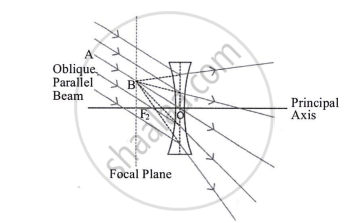Advertisements
Advertisements
Question
A parallel, oblique beam of light falls on a concave lens. Draw a diagram to show refraction of light through the lens.
Solution

The concave lens in the accompanying diagram is refracting a parallel, oblique beam of light.
APPEARS IN
RELATED QUESTIONS
Fill in the following blank with suitable word:
Lenses refract light to form images: a..................... lens can form both real and virtual images, but a diverging lens forms only ...................... images.
Which type of lens is :
a converging lens, and which is
Which type of lens is
a diverging lens? Explain your answer with diagrams.
An object is placed 10 cm from a lens of focal length 5 cm. Draw the ray diagrams to show the formation of image if the lens is diverging.
The power of a converging lens is 4.5 D and that of a diverging lens is 3 D. The power of this combination of lenses placed close together is :
(a) +1.5D
(b) +7.5D
(c) −7.5D
(d) −1.5D
State whether the following statement is true or false:
Short-sightedness can be cured by using a concave lens.
A person cannot see distant objects clearly. His vision can be corrected by using the spectacles containing:
(a) concave lenses
(b) plane lenses
(c) contact lenses
(d) convex lenses
Explain the working of an astronomical telescope using refraction of light.
An object is placed in front of a lens between its optical centre and focus. The formed image is virtual, erect, and diminished. Name the lens used.
Distinguish between:
Concave Lens and Convex Lens
